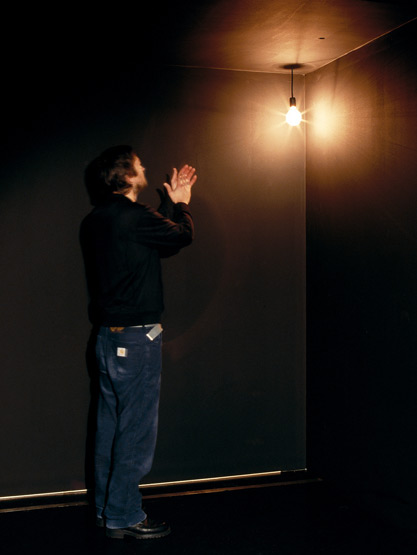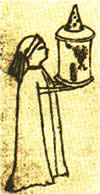 This design is incredibly beautiful, but sadly was never built. Here Ando designs carefully and deliberately with light, considering how it interacts with the form of his building and with the water passing through the building. The rendering is especially revealing, showcasing light’s smooth gradation across the building itself, the reflections of the light on the water, and the shadows cast on the water by the building form. By keeping the form and materials simple, Ando is able to highlight the behavior of light where it otherwise may be overwhelmed by shapes and colors competing for our attention. While I don’t intend to use water in my design, I would like to design my installation in a way that’s as considerate to and interactive with the environment as much as Ando’s design is to his.
This design is incredibly beautiful, but sadly was never built. Here Ando designs carefully and deliberately with light, considering how it interacts with the form of his building and with the water passing through the building. The rendering is especially revealing, showcasing light’s smooth gradation across the building itself, the reflections of the light on the water, and the shadows cast on the water by the building form. By keeping the form and materials simple, Ando is able to highlight the behavior of light where it otherwise may be overwhelmed by shapes and colors competing for our attention. While I don’t intend to use water in my design, I would like to design my installation in a way that’s as considerate to and interactive with the environment as much as Ando’s design is to his.More information on the museum's design can be found here: http://desmena.com/?p=68
Kumi Yamashita’s Shadow Art
 A link to Kumi Yamashita’s site: http://kumiyamashita.com/
A link to Kumi Yamashita’s site: http://kumiyamashita.com/Yamashita creates extraordinary and detailed shadows from ordinary objects. To do this, Kumi has to have a strong working knowledge of the exactly type of light source and its location, the location of every individual object, and the location and material of the screen onto which the shadows are projected. The alterations to the shadow-caster often seem subtle at first, but can create drastic shadow effects.
(untitled work) from Prisoner’s Creative Arts Project
 I picked up this drawing from the Prisoner’s Creative Arts Project last year. Unfortunately I was not given the tag with the piece’s title, or the artist’s name, so that information has sadly been lost. Through only a small range of colors, this drawing demonstrates every possible way that light can interact with clouds: shining through them, backlighting them, front lighting them, making them cast shadows, making them glow. The source remains constant, but the position, density, and thickness of the clouds are all different, and thus cause the light to interact differently with them. This work shows how by keeping some parts simple – the color scheme, only using clouds, etc – a wide variety of light interactions can be the entire focus of a piece.
I picked up this drawing from the Prisoner’s Creative Arts Project last year. Unfortunately I was not given the tag with the piece’s title, or the artist’s name, so that information has sadly been lost. Through only a small range of colors, this drawing demonstrates every possible way that light can interact with clouds: shining through them, backlighting them, front lighting them, making them cast shadows, making them glow. The source remains constant, but the position, density, and thickness of the clouds are all different, and thus cause the light to interact differently with them. This work shows how by keeping some parts simple – the color scheme, only using clouds, etc – a wide variety of light interactions can be the entire focus of a piece. Canopies of leaves on a sunny day are a direct inspiration for this last project. I have always found it beautiful when the sun lights leaves from behind, rendering them semi-transparent so you can see the veins of the leaf and silhouettes of the leaves and branches behind it. I would like to capture this effect somehow, using sunlight to create some level of transparency in a material, but also capturing the shadows of the leaves and branches above it.
Canopies of leaves on a sunny day are a direct inspiration for this last project. I have always found it beautiful when the sun lights leaves from behind, rendering them semi-transparent so you can see the veins of the leaf and silhouettes of the leaves and branches behind it. I would like to capture this effect somehow, using sunlight to create some level of transparency in a material, but also capturing the shadows of the leaves and branches above it.Scott Clark Photography
 First, a link to Scott Clark’s photography website: http://scottfoto.blogspot.com/
First, a link to Scott Clark’s photography website: http://scottfoto.blogspot.com/From what I have seen, Scott Clark does not always make light the focus of his photography (though at times he certainly does) but I feel like the viewer is always made aware of the light conditions nonetheless. The lighting seems to always be deliberate, or well taken into account… the shadows of subjects are framed as carefully as the subjects themselves. In every case I can see, the lighting is natural, be in sunlight or firelight, and the colors are all very vibrant. I would like to be able to create a similar awareness of light and shadow, though perhaps more directly in my project.






























.jpg)


















